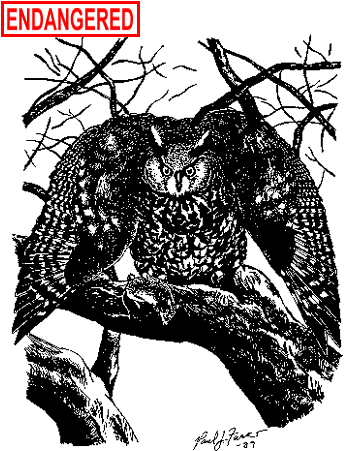Long-eared Owl
Asio otus

Habitat: Thick woods; roosts in dense stands of evergreens or vine-covered thickets; breeds in woodlands or riverine woodland belts; forages in openings and old fields.
Weight: Males - 8.6 ounces; females - 9.9 ounces.
Length: 13-16 inches.
Wingspan: 36-42 inches.
Life Expectancy: 25-30 years of age.
Food: Mice and voles; also rats and other rodents, young rabbits and occasionally small birds or snakes.
Status: State endangered.
Identification: Adult long-eared owls have a slender, gray-brown body and a bold breast with vertical streaks. The ear tufts, located near the center of the head, are long and blackish. This owl also has a rusty facial disk edged with black and gray, a gray-black bill and yellow eyes. It is smaller, less bulky and lacks the white throat patch and cross-barred breast of the great-horned owl. The sexes are similar, although females are slightly larger.
The long-eared owl is generally silent except during the breeding season. Its common call is a long, single "whooo" or a soft, musical series of "whooo-whooo-whooo."
Range: The long-eared owl nests from New Brunswick and Nova Scotia south through Virginia and west from southern Manitoba and British Columbia south to southern California, northern Arizona and New Mexico, and northwestern Texas. Some southward migration from the northern part of the range occurs in the fall. The winter range extends south to Baja, California, northern Mexico and Texas, and east to northern Florida.
Reproduction: The species breeds in the northern United States and Canada in mid-April. Large, abandoned nests of other birds or squirrels are used by these owls; occasionally they nest in hollows on the ground. The 4 to 5 glossy, white eggs are laid on alternate days. Incubation begins when the first egg is laid and lasts 25 to 30 days. The female usually incubates the eggs. Nestlings are covered with a soft, thick, white down that extends to the claws. Males bring food to the nest and females feed the young. The young leave the nest after 23 to 24 days, but are unable to fly until they are about 34 days old.
Reason for Decline: Long-eared owl populations are mainly limited by the loss of habitat due to land development, forest thinning and the conversion of softwood forests to hardwood forests. They are also affected by the decline in suitable nest sites, predation and the decrease in prey abundance. In Connecticut, because of changing land use practices and the decline in farming, fields have either been overtaken by development or they have reverted to forests. Open areas and fields are used extensively by voles and mice and are thus heavily hunted by long-eared owls.
History in Connecticut: The long-eared owl was a common Connecticut resident in the late 1800s, nesting in thick evergreen stands and in low brush along the coast. Populations began to decline around 1900. Long-eared owls are now uncommon winter visitors along the coast and the Connecticut River valley from November through mid-April; they are seldom seen inland. The species now rarely nests in Connecticut.
Interesting Facts: Long-eared owls are more strictly nocturnal than any other North American owl except the saw-whet. When disturbed in a day roost, the owl will raise its ear tufts, compress its feathers tightly against its body and freeze, thus resembling tree bark or a broken limb. This statue-like, "erect-eared" pose led this bird to be known at one time as the cat owl.
The flight of the long-eared owl has been compared to that of a large moth, light and buoyant. The owl flies with its ear tufts flattened against its head.
Protective Legislation: Federal - Migratory Bird Treaty Act of 1918. State - Connecticut General Statutes Sec. 26-92, Sec. 26-95, Sec. 26-98 and Sec. 26-311.
What You Can Do: Plant conifers near open areas or deciduous woodlots to provide needed cover for long-eared owls. Scotch pine, red cedar, spruces, hemlock and arborvitae are favored over pines because they provide a tighter, more dense network of branches and needles. Periodically mow or allow grazing of fallow fields or open areas to help prevent forest succession and maintain important owl hunting areas. The protection of marshlands and grasslands is also important for maintaining a stable food source for the owls. Reducing the use of pesticides, which may contaminate the owl's food supply, will help insure that breeding and nesting owls are not affected by these deadly compounds.

The production of this Endangered and Threatened Species Fact Sheet
Series is made possible by donations to the Endangered Species/Wildlife Income Tax
Checkoff Fund.
(rev. 12/99)

